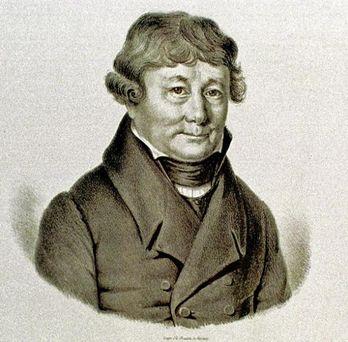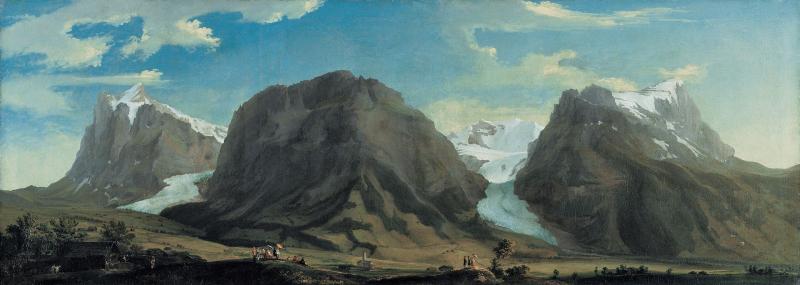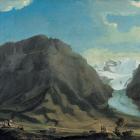Philippe-Sirice Bridel (1757–1845) was a French-speaking Swiss man of letters, known for his writings on local folk traditions and Swiss poetry. Through his publications, like the almanac Etrennes helvétiennes, published from 1783 onward, assembled in the thirteen-volume work Conservateur Suisse between 1813 and 1831, he contributed to the construction of the image of Switzerland as an idyllic place where the inhabitants live in peace and symbiosis with nature—taking up themes formulated by Albrecht von Haller (1708–1777), Jean-Jacques Rousseau (1712–1778), and Salomon Gessner (1730–1788), lovers of the alpine landscape.

Portrait of Philippe-Sirice Bridel (1757–1845).
Portrait of Philippe-Sirice Bridel (1757–1845).
n.d., unknown artist. Accessed via Wikimedia Commons.
 This work is licensed under a Creative Commons Public Domain Mark 1.0 License.
This work is licensed under a Creative Commons Public Domain Mark 1.0 License.
Bridel’s travel diary from July 1775, Journal entre Lausanne, Château d’Oex et Montreux, reveals his marked interest in the beauty of the landscape and its beneficial influence on the population. While still a young theology student in Lausanne, the future poet traveled for a few days in the mountains of the Pays de Vaud and Valais, during which he describes his sensations. Happy to leave the “boring city”* of Lausanne, he imagines a peaceful life between the “sweet sound of the stream” and the “silence of the woods”—and above all, he evokes the mountains, “inaccessible rocks, noisy cataracts, landscapes sometimes pleasant, sometimes awful, always picturesque.” This landscape gives him an intense sentiment of individual freedom, but also of collective harmony. He is certain that “in the mountains there is more equality.” Convinced that he has discovered the ancestral Switzerland so highly praised by his predecessors, the young traveler takes up all the clichés associated with Helvetia, thereby proving the extent to which the philhelvetian discourse permeates the mentalities of the enlightened urban elite.
After having delineated at length the characteristics of the “true” Swiss—according to him, good, proud, free, honest, simple, and tough—the author describes the encounter he has with an old man from the Valais that he finds sitting in front of his chalet, in contemplation. The latter asks the traveler where he comes from, and hearing that he comes from the Pays de Vaud, pities him because he has limited freedom: Vaud was at that time a subject to the canton of Bern. Bridel answers: “I was made to be a slave of freedom, I cherish the mountains, their inhabitants, how am I not your compatriot?” The two men then embrace. The author concludes: “I lost sight of him while reflecting on the singularity of this encounter, astonished to have found in the middle of the Alps under disgraceful clothes a soul so beautiful, so noble.”

Caspar Wolf, Panorama of Grindelwald with the Wetterhorn, Mettenberg and Eiger, 1774. Kunsthaus Zürich.
Caspar Wolf, Panorama of Grindelwald with the Wetterhorn, Mettenberg and Eiger, 1774. Kunsthaus Zürich.
Accessed via Wikimedia Commons.
 This work is licensed under a Creative Commons Public Domain Mark 1.0 License.
This work is licensed under a Creative Commons Public Domain Mark 1.0 License.
Philippe-Sirice Bridel describes the Alps as the place where “man [lives] a little closer to nature, content in the midst of snow and frost, braving the inclemency of the seasons and triumphing over their fury.” This contrast between the wilderness of nature in the mountains and the tranquility of the people who live there is characteristic of descriptions of the Alps during the second half of the eighteenth century. According to the romantic elite perception of the time, Switzerland was considered as the Alpine country par excellence (“Alpenland” in German), comprised of a variety of landscapes, reflecting the diversity of the Swiss population. This idealized perspective shared by the young traveler emphasizes that despite their religious divergences (Catholics and Protestants), linguistic differences (German, French, and Italian), and, above all, their distinct ways of life (as the encounter between the young city-dweller Bridel and the old mountain man demonstrates), the inhabitants of the Helvetic Confederation share a love of an idyllic homeland embodied by the Alps. This description of the environment blends aesthetic considerations of the sublime and picturesque and makes Bridel’s diary a classic example of the Romantic perception of the landscape and its inhabitants emerging at that time.
Bridel’s work is based on a naturalizing conception that links the character of each people to the specificities of its environment: In Switzerland, the spirit of freedom and brotherhood would result from the symbiosis between mountains and individuals. Following in the footsteps of von Haller, Rousseau, and Gessner, Bridel develops a patriotic perspective that links the surrounding nature with human nature. The pure mountain air, the picturesque landscape, and the nobility of the old man’s soul give the narrator serenity. He insists on the strong link between the Alps and Switzerland, helping to build a national identity based on the image of the mountains as a symbol of unity. As such, Bridel’s youthful diary synthesizes the political and aesthetic issues related to the environment in the second half of the eighteenth century and foreshadows the importance of natural elements in Swiss national discourse in the nineteenth century.
* As there is no published translation of this work to date, all the quotes are personal translations.
How to cite
de Félice, Nicolas. “Philippe-Sirice Bridel, the Natural Landscape, and the Swiss National Sentiment.” Environment & Society Portal, Arcadia (Autumn 2022), no. 16. Rachel Carson Center for Environment and Society. doi:10.5282/rcc/9537.
ISSN 2199-3408
Environment & Society Portal, Arcadia
 This work is licensed under a Creative Commons Attribution 4.0 International License.
This work is licensed under a Creative Commons Attribution 4.0 International License.
2022 Nicolas de Félice
This refers only to the text and does not include any image rights.
Please click on the images to view their individual rights status.
- Bridel, Philippe-Sirice. Journal entre Lausanne, Château d’Oex et Montreux. Bibliothèque de Genève (BGE), Ms. Supp. 689, July 1775.
- Mathieu, Jon, and Simona Boscani Leoni, eds. Die Alpen! Zur europäischen Wahrnehmungsgeschichte seit der Renaissance. Les Alpes! Pour une histoire de la perception européenne depuis la Renaissance. Bern: Peter Lang, 2005.
- Reichler, Claude. La découverte des Alpes et la question du paysage. Geneva: Georg, 2002.
- Speich, Daniel. “Switzerland.” In Nations and Nationalism: A Global Historical Overview, vol. 1, edited by Guntram H. Herb and David H. Kaplan, 244–55. Santa Barbara: ABL-CLIO, 2008.
- Walter, François. Les Suisses et l’environnement: Une histoire du rapport à la nature du XVIIIe siècle à nos jours. Geneva: Zoé, 1990.








